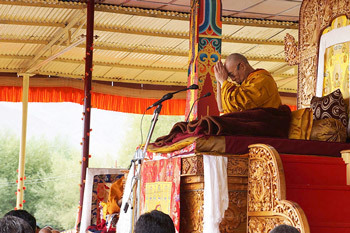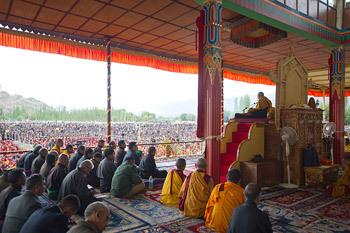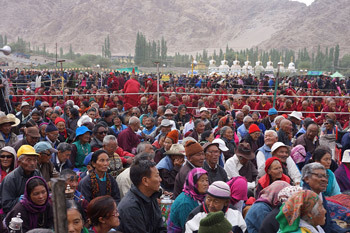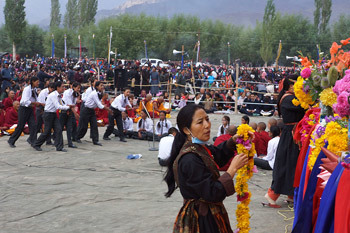Leh, Ladakh, J&K, India, 6th August 2012 - His Holiness reached the teaching platform before 6am to begin the preparatory rituals for the Lokeshvara empowerment he was going to give today. While he was doing those preparations, and the public were arriving to take their seats, a group of local school students, girls and boys, demonstrated their command of traditional debate techniques, some of them standing and issuing challenges to their seated fellows who responded. This is something His Holiness has specifically encouraged. Meanwhile, a steady stream of local people brought garlands and bunches of fresh flowers, apparently from their own gardens, to decorate the platform. These were to be offered during the ceremonies for generating the awakening mind and the granting of the Bodhisattva vows.
“The Buddha said ‘do not commit unwholesome deeds, practise only virtue’. If the our motivation is negative, the resulting action will also be negative. The Buddha taught us to avoid negative action, because it is in our own interest. Helping the poor and needy with food and medicine is very good, but the most important thing to do is to develop an altruistic attitude. To accomplish that we have to subdue the mind, to subdue our selfish motives and dedicate ourselves to the well-being of others.”
Nagarjuna said that if we wish to attain enlightenment for the benefit of ourselves and others, we need to cultivate compassion and the wisdom understanding emptiness. An altrustic attitude is essential if we wish to achieve Buddhahood. The awakening mind of Bodhichitta is the attitude that is of benefit to all. It includes compassion and the extraordinary resolve to help others. His Holiness remarked,
“Although I don’t have Bodhichitta myself, I have great admiration for it. From the age of 14, I seriously studied emptiness and made it my focus. I thought of Bodhichitta as something very good, but also very hard to achieve. On the other hand I had a sense that it was possible to realise emptiness, that it was within reach, and I remember thinking that it would be possible to achieve liberation and take a long rest. Then I received an explanation of Shantideva’s Guide to the Bodhisattva’s Way of Life from Khunu Lama Rinpoche and I began to realise that if there was time and the opportunity to practice it should be possible to develop Bodhichitta.”
His Holiness said that we all have seeds of compassion linked to the biological factor of having been cared for with affection by our mothers. This natural potential for warm-heartedness tends to be wrapped up with attachment, but we can modify and overcome this by engaging in such practices as ‘exchanging self with others’. One of the best ways of making this precious human life meaningful is to realise that nothing relieves suffering better than cultivating Bodhichitta.

|
His Holiness the Dalai Lama offers a brief prayer prior to the beginning of his teachings in Leh, Ladakh, J&K, India, on August 6, 2012. Photo/Jeremy Russell/OHHDL
|
As part of the ceremonial development of the awakening mind of Bodhichitta, and the Bodhisattva vows, His Holiness announced that he would give the lay-person’s precepts that consist of five basic pledges: not to take human life; not to take what is not given; not to engage in sexual misconduct; not to tell big lies, which he explained as referring particularly to, for example, exaggerating your spiritual attainments, which is something that people like him sitting on thrones have to beware of; and not to take intoxicants. His Holiness led those who wished to take these vows through the recitations, telling them to think, at the end of the third repetition, when he snapped his fingers, that they had received them.
After this, he led the congregation through the rite to develop aspiring Bodhichitta, recommending that they visualise the Buddha himself, surrounded by Bodhisattvas, his main disciples, and the great masters of India, Tibet and Ladakh as witnesses before them. Generating this awakening mind is to aspire to lead all sentient beings to the state of omniscience and not to let this mind decline.
Reading through the remaining verses of the two texts His Holiness discussed the qualifications of a spiritual teacher, mentioning that in his Ornament of Sutras, Maitreya lists ten qualities such as being knowledgeable and showing compassion for others. The pre-eminent factor is that you cannot help others subdue their minds unless you have made some progress in subduing your own.
Discussing the practice of developing a calmly abiding mind as part of the six perfections, the practice of a Bodhisattva, His Holiness explained how you select an object, examine it carefully with your eyes and form a clear image of it in your mind. This mental object is the object in relation to which you will develop calm abiding. Calm abiding is not cultivated through the senses, but with the mind. He went on to clarify that just as you can select an external object as the source of the mental image on which you meditate, you can also choose an internal object like the inner channels or letters within them. You can also take your mind as the object. In the Tibetan Buddhist tradtion it is common to develop a calmly abiding mind based on deity yoga practices.
 |
| His Holiness the Dalai Lama speaking during his
third day of teachings in Leh, Ladakh, J&K, India, on August 6,
2012. Photo/Namgyal AV Archive |
With regard to wisdom, His Holiness said we should remember that appearance does not necessarily correspond to reality. What appears may not necessarily exist the way it appears and even what is designated by the mind may also not exist the way it appears. This is where analysis is important. To overcome our ignorance and misunderstandings we needs to apply counter measures, just as fire dispels cold and light dispels darkness. In his Three Principal Aspects of the Path Tsongkhapa explains how we need to understand both emptiness of inherent existence and dependent arising and how they relate to each other. At the end of his text he advises Ngawang Drakpa, and by extension us too,
“.... when you realize the keys of the three principal aspects of the path,
(the determination to be free, the awakening mind of Bodhichitta and wisdom) depend on solitude and strong effort
and quickly reach the final goal.”
His Holiness explained that Ganden Tri Rinpoche (the 103rd successor to Je Tsongkhapa as spiritual head of the Gelugpa tradition) had requested him to give the empowerment of Mahakarunika Lokeshvara. He said this was significant because Ladakh is Tibet’s neighbour and there is a longstanding special bond between them and there is likewise a special bond between His Holiness and Rizong Rinpoche, the present Ganden Throne-holder, This practice derives from a vision the Fifth Dalai Lama had when he was 40 years old. He was undertaking an Avalokiteshvara meditation retreat when he had a vision in which Songtsen Gampo appeared from the heart of one of the Avalokiteshvara images in the room with him and gave him this empowerment. The 13th Dalai Lama used to perform rituals in connection with this practice on 10th of the Tibetan month and in connection with Hayagriva on 25th of the month; a practice His Holiness likes to emulate.
As part of the ritual His Holiness gave the assembled public Bodhisattva vows, telling them that he takes them afresh every day and dedicates the merit to the welfare of all sentient beings. He said,

|
Members of the audience attending His Holiness the Dalai Lama's teachings in Leh, Ladakh, J&K, India, on August 6, 2012. Photo/Jeremy Russell/OHHDL
|
“The main thing is not to do anyone any harm and to do whatever you can to be of help to others. If you do that, you won’t give rise to those actions that are regarded as downfalls from these vows.”
In conclusion, His Holiness mentioned that the text he was using had been composed on the basis of the 5th Dalai Lama’s vision by Jamyang Khyentse Wangpo, a Lama who like the 5th Dalai Lama adopted an ecumenical approach, as did his disciples and successors like Jamyang Khyentse Chökyi Lodro, Dilgo Khyentse Rinpoche and Trulshik Rinpoche.
His Holiness announced that he will give a White Tara Long Life Empowerment tomorrow, which will be followed by a ceremony praying for his long life. He said,
“The Lamas here will pray that I live long and I will too. Moreover, as the Ganden Tri Rinpoche is now quite old, we should all pray for his long life and I will do so too. And as this is the anniversary of the dreadful flash flood that struck this region two years ago we should all pray for the victims of that as well.”
















